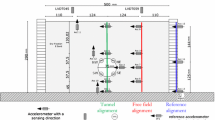Abstract
In this paper, a comparison between numerical analyses and centrifuge test results relative to the seismic performance of a circular tunnel is provided. The considered experimental data refer to two centrifuge tests performed at Cambridge University, aimed at investigating the transverse dynamic behaviour of a relatively shallow tunnel located in a sand deposit. For the same geometry, different soil relative densities characterise the two tests. The four seismic actions considered, of the pseudo-harmonic type, are characterised by increasing intensity. The 2D numerical analyses were performed adopting an advanced soil constitutive model implemented in a commercial finite element code. The comparison between numerical simulations and measurements is presented in terms of acceleration histories and Fourier spectra as well as of profiles of maximum acceleration along free-field and near-tunnel verticals. In addition, loading histories of normal stress and bending moments acting in the tunnel lining were considered. In general, very good agreement was found with reference to the ground response analyses, while a less satisfactory comparison between observed and predicted results was obtained for the transient and permanent loadings acting in the lining, as discussed in the final part of the paper.





















Similar content being viewed by others
References
Amorosi A, Boldini D (2009) Numerical modelling of the transverse dynamic behaviour of circular tunnels in clayey soils. Soil Dyn Earthq Eng 29:1059–1072
Amorosi A, Boldini D, Elia G (2010) Parametric study on seismic ground response by finite element modelling. Comput Geotech 37:515–528
Amorosi A, Boldini D, Palmisano F (2010b) Analysis of tunnel behaviour under seismic loads by means of simple and advanced numerical approaches. In: Fifth international conference on recent advances in geotechnical earthquake engineering and soil dynamics, San Diego, 5.80a, p 12
Amorosi A, Boldini D, Postiglione G. (2012) Analysis of tunnel behaviour under seismic loads: the role of soil constitutive assumptions. In: Second international conference on performance-based design in earthquake geotechnical engineering, Taormina, pp 1590–1601
Bardet JP, Ichii K, Lin Ch (2000) EERA—a computer program for equivalent-linear earthquake site response analyses of layered soils deposits. User manual
Bathe KJ (1982) Finite element procedures in engineering analysis. Prentice Hall, Upper Saddle River
Bilotta E, Lanzano G, Russo G, Silvestri F, Madabushi G (2009) Seismic analyses of shallow tunnels by dynamic centrifuge tests and finite elements. In: 17th international conference on soil mechanics and geotechnical engineering: the academia and practice of geotechnical engineering, Alexandria, pp 474–477
Bilotta E, Silvestri F (2012) A predictive exercise on the behaviour of tunnels under seismic actions. In: 7th international symposium on geotechnical aspects of underground construction in soft ground, Rome, pp 1071–1077
Brennan AJ, Thusyanthan NI, Madabhushi SPG (2005) Evaluation of shear modulus and damping in dynamic centrifuge tests. J Geotech Geoenviron Eng 131(12):1488–1497
Gomes RC (2012) Effect of stress disturbance induced by construction on the seismic response of shallow bored tunnels. Comput Geotech 49:338–351
Hardin B, Drnevich V (1972) Shear modulus and damping in soils: design equations and curves. J Soil Mech Found Division 98(7):667–692
Jâky J (1948) The coefficient of earth pressure at rest. J Union Hung Eng Arch 78(22):355–358
Khoshnoudian F, Shahrour I (2002) Numerical analysis of the seismic behaviour of tunnels constructed in liquefiable soils. Soils Found 42(6):1–8
Kouretzis GP, Sloan SW, Carter P (2013) Effect of interface friction on tunnel liner internal forces due to seismic S- and P-wave propagation. Soil Dyn Earthq Eng 46:41–51
Lanzano G (2009) Physical and analytical modeling of tunnels under dynamic loadings. Ph.D. thesis, University of Naples
Lanzano G, Bilotta E, Russo G, Silvestri F, Madabhushi PG (2009) Experimental assessment of performance-based methods for the seismic design of circular tunnels. In: International conference on performance-based design in earthquake geotechnical engineering, Tokyo
Lanzano G, Bilotta E, Russo G, Silvestri F, Madabhushi PG (2012) Centrifuge modelling of seismic loading on tunnels in sand. Geotech Test J 35(6):1–16
Lysmer J, Kuhlemeyer RL (1969) Finite dynamic model for infinite media. ASCE EM 90:859–877
Plaxis 2D (2009) Reference manual. Version 9.0. http://www.plaxis.com
Santos JA, Correia AG (2001) Reference threshold shear strain of soil. Its application to obtain a unique strain-dependent shear modulus curve for soil. In: 15th international conference on soil mechanics and geotechnical engineering, Istanbul, Vol. 1, pp 267–270
Shahrour I, Khoshnoudian F (2003). Analysis of the seismic behaviour of tunnels constructed in soft soils. In: International workshop on geotechnics of soft soils—theory and practice. Noordwijkerhout, pp 339–44
Schanz T, Vermeer PA, Bonnier PG (1999) The hardening soil model: formulation and verification. In: Plaxis symposium on beyond 2000 in computational geotechnics, Amsterdam, pp 281–296
Sedarat H, Kozak A, Hashash YMA, Shamsabadi A, Krimotat A (2009) Contact interface in seismic analysis of circular tunnels. Tunnel Undergr Space Technol 24:482–490
Tsinidis G, Pitilakis K (2012) Seismic performance of circular tunnels; centrifuge testing versus numerical analysis. In: Second international conference on performance-based design in earthquake geotechnical engineering, Taormina, pp 1578–1589
Visone C, Santucci de Magistris F (2009) Mechanical behaviour of the Leighton Buzzard sand 100/170 under monotonic, cyclic and dynamic loading conditions. In: XIII conferenza sull’Ingegneria Sismica in Italia, ANIDIS, p 10
Wang JN (1993) Seismic design of tunnels: a state-of-the-art approach. Monograph 7. Parsons Brickerhoff, New York
Yang D, Naesgaard E, Byrne PM, Adalier K, Abdoun T (2004) Numerical model verification and calibration of george massey tunnel using centrifuge models. Can Geotech J 41:921–942
Zeghal M, Elgamal AW (1994) Analysis of site liquefaction using earthquake records. J Geotech Eng 120(6):996–1017
Acknowledgments
Financial support provided by the research program ReLUIS 2010–2013, funded by the Italian Civil Protection Department, is gratefully acknowledged.
Author information
Authors and Affiliations
Corresponding author
Rights and permissions
About this article
Cite this article
Amorosi, A., Boldini, D. & Falcone, G. Numerical prediction of tunnel performance during centrifuge dynamic tests. Acta Geotech. 9, 581–596 (2014). https://doi.org/10.1007/s11440-013-0295-7
Received:
Accepted:
Published:
Issue Date:
DOI: https://doi.org/10.1007/s11440-013-0295-7




